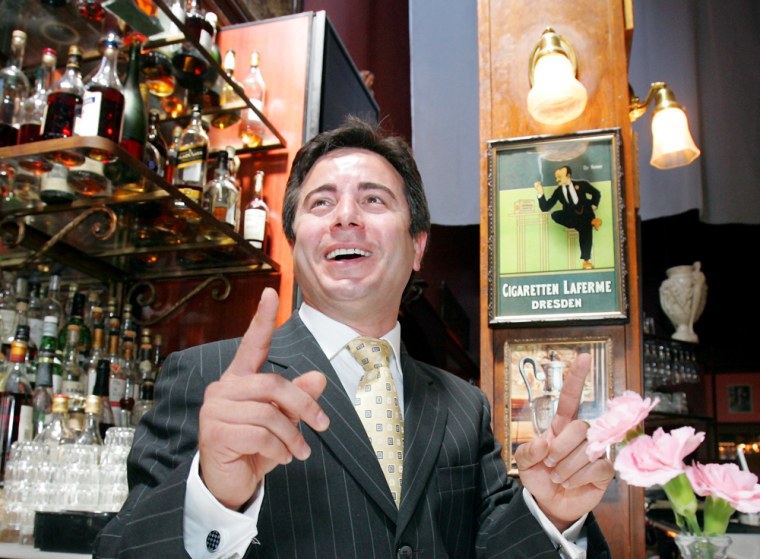After finishing dinner at a Connecticut restaurant, two diners got more than a butter mint when a waiter, apparently miffed by a $2 to $3 tip left on a $50 check, attacked them with a knife. They only suffered minor injuries, but no doubt tipped much better after that.
While violent cases of waiter rage are rare, the 1989 incident points to waiters' sticky reliance on tips for income. In some states, restaurants are only legally required to pay as little as $2 or $3 an hour. So if a server earns $30 in tips on a bad night, he could feasibly walk out having earned less than minimum wage after tipping out the bartender and busboys (a common practice in most restaurants).
To level the playing field, waiters are taking action. Some are resorting to guerrilla tactics — it's not uncommon for waiters to personally confront stingy tippers, or to blog about them on sites such as WaiterRant.Net.
One former waiter, Yakup Ulutas, is proposing restaurants change the system. Ulutas, a 36 year-old restaurant manager in Atlanta, founded a nonprofit organization, Fairtip.org, to persuade restaurants to implement an automatic 20 percent service fee on every check. He estimates 2,500 waiters have joined.
You'd be hard-pressed to find a server who wouldn't love to see his or her employer slap an automatic tip on to every check. But wouldn't it make more sense for restaurants to hike prices by 20 percent and raise workers' salaries?
"That wouldn't work," Yakup says. "Many restaurants wouldn't be able to afford to pay higher wages."
The low-margin restaurant business is a notoriously difficult one. Raising server wages could easily zap the profits of small to mid-sized restaurants.
But diners have also seen a rapid rise in the tipping rate. Zagat Survey, which surveys the top restaurants nationwide, found that the average tip has increased to 18.7 percent in 2006 from 17.75 percent in 2000.
At least one academic thinks that if the tipping rate rises too high, eating out will become prohibitive for many people, and restaurant sales will stall.
"Tipping is about buying social approval, and the way you do that is to at least tip an average amount, but most people want to tip a little bit better than average. That exerts an upward pressure on tips," says Michael Lynn, an associate professor at Cornell University School of Hotel Administration.
It would make sense for the restaurant industry to establish a norm before tipping rates move up to the point of pricing diners out of the market, he said.
While most restaurants already charge an automatic service fee for large parties, at least one restaurant began the practice of charging an automatic 20 percent gratuity, or "autograt," as it is sometimes called, on every check.
Per Se, a pricey New York restaurant started by star chef Thomas Keller, caused a public outcry when it implemented a 20 percent service fee last year. All prix fixe menus at Per Se cost $210, according to the restaurant's web site, so assuming customers spend about $100 for wine, a tip is likely to total around $60. Still, the restaurant said no patrons have refused to pay the service fee, and some guests actually tip above the required amount.
It may sound like a lucrative arrangement, but some waiters would rather take their chances and brave the risk of not making money.
"For as much disappointment as there is in waiting tables, regulating tips might detract from the sense that if you do your job well, you'll be rewarded," says Melissa Klein, a 25 year-old waitress at Lodge restaurant in Brooklyn, N.Y.
It's a common belief — that tips are based on service — but Lynn argues it's all wrong. Research has shown that tips are rarely based on the quality of service, and are usually determined arbitrarily.
"Servers think there's a relationship between tips and service, but there isn't. How sunny it is outside literally has as big of an impact on a tip as the service," Lynn says.
One study showed that when waitresses wore flowers in their hair they earned 17 percent more than when they didn't. Another study suggests that waiters who squat beside tables receive an average tip of 18 percent, versus a 15 percent tip received by waiters who stand next to their tables.
Some waiters concede that tipping behavior has very little to do with service. Theresa Burkhart, a 31 year-old waitress and actress in Manhattan, says overtippers tend to overtip regardless of service, and undertippers tend to undertip; Canadians and Brits often tip 10 percent, while Japanese customers tip around 20 percent.
Burkhart herself says she tips a minimum of 20 percent across the board.
"I find it unacceptable for people not to know that the tipping rate is 20 percent," Burkhart said.
The sentiment is widely shared on the Internet; a database started on one Web site — bitterwaitress.com — allows servers across the country to submit the names of customers who tipped less than 17 percent. Actress Sandra Bernhard is listed in the database for having skipped out on a tip after eating a $120 comped dinner at a Rochester, N.Y. club where she performed.
While public humiliation may be a low blow, it's still preferable to stabbing stingy tippers.
